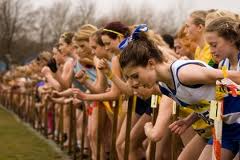Year round training for a single sport is becoming increasingly more popular amongst youth athletes. Although this is most common in baseball and gymnastics, running is gaining in popularity. Most high school cross-country runners now run year round. As a parent, the number of miles your child logs, especially during the summer, may concern you. These concerns may be justified when you look at the evidence regarding the health and development effects of non-stop run training on adolescent athletes.
One of the most common concerns stated by parents of adolescent distance runners is that their child is a healthy weight. Low body mass in competitive endurance athletes is the norm, but at what point should it be a concern for your child’s health? Comparing your child’s weight to other children’s may not be the best comparison. One in three children is overweight1, which may lead you to falsely assume your child is too thin. The best way to determine if your child is a healthy weight is to use BMI Percentile Calculator for Children and Teens provided by the Centers for disease Control Prevention (CDC): CDC Child BMI Percentile Calculator Link
Achieving and maintaining a healthy weight while training for cross county has an added challenge when it comes to adolescents. Often youth athletes are still growing. Meeting the nutritional needs necessary for proper growth and development can be difficult when paired with the increased nutrient demands of high volume run training. An hour practice run can increase your child’s calorie needs by 500- 1000 calories. It is not uncommon to see overly thin high school endurance runners as they grow but do not seem to put on any additional weight with their added height. This is due to the child not being able to eat calories at the same rate they are needed to support both exercise expenditure and growth demands. In addition to increased calorie needs, youth distance runners must ensure they get adequate calcium and iron, which are most often deficient in this population.2
All athletes should have an off-season incorporated into their training schedule. This is a key part of proper periodization training. A periodized training schedule typically contains a pre-season, season, and off-season. Each of these training times is especially important for the health of the year-round adolescent distance runner. The American Academy of Pediatrics Council on Sports Medicine and Fitness recommends single sport athletes take at least two-three months off per year from their particular sport.3 Cross-training during off season has many benefits, both sport performance wise as well as nutrition and health wise.
Cross-country runners already have a very high risk for injury. 38.5% of high school cross country runners sustain an injury that prevents them from participating in their full season. The biggest risk factor for injury during season is getting an injury in off-season.4 50% of all pediatric sport injuries are related to overuse.3 Running in off-season dramatically increases your child’s risk for injury. Injuries in adolescent athletes most commonly occur during peak growth times. This is not surprising when you consider the battle for increased nutrition for exercise and development requirements as well as the physical adaptations required for changes in muscle and structure. Cross training during the off season, especially if it involves strength training, not only improves running performance, 5 it reduces your child’s risk of injury and provides much needed time for them to catch up on nutrition necessary for proper development.
1.) CDC. About BMI for Children and Teens. Accessed August 2012. http://www.cdc.gov/healthyweight/assessing/bmi/childrens_bmi/about_childrens_bmi.html/
2.) Petrie HJ, Stover EA, Horswill CA. Nutrition Concerns for the Child and Adolescent Competitor. July 2004. 20(7): 6220-631
3.) Brenner JS. And the American Academy of Pediatrics. Overuse Injuries, Overtraining, and Burnout in Child and Adolescent Athletes. Pediatrics. June 2007. 119(6): 1242-1245.
4.) Rauh MJ, Koepsell TD, Rivara FP, et al. Epidemiology of Musculoskeletal Injuries Among High School Cross-Country Runners. American Journal of Epidemiology. Jan. 2006. 163(2): 151-159
5.) Tanaka H, Swensen T. Impact of Resistance Training on Endurance Performance: A New Form of Cross-Training? Sports Medicine. March 1998. 25(3): 191-200
